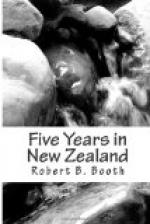Our bag was now six pigs, of which four were boars, and we had been actually hunting for about three hours, including the time spent in making the detour. After cutting off a ham and the head of the last boar, we carried them back to where we left Forde with his wounded horse. Legge had already arrived, and we all sat down to take some food while awaiting the arrival of the dray.
The remainder of the herd had reached the hills long since, and there was no more sport to be had in the neighbourhood that day. Forde removed his saddle and bridle to be sent on the dray and turned his horse loose to find his way to the run, while he started on foot to the nearest station to procure another mount to carry him home. The rest of us proceeded to a flat near the first gorge of the Ashburton, where we succeeded in killing five other pigs before the evening closed. Forde’s horse reached his station as soon as his wounded leg permitted him, but the wound being found more serious than anticipated, and that he would be lame for life, it was decided to destroy him.
CHAPTER IX.
CATTLE RANCHING AND STOCKRIDING.
While I stayed at Smith’s Station, we made acquaintance with a young man, by name Hudson, a son of the famous Railway King. He had come to New Zealand a few years previously with slender means and was a pushing, energetic fellow. He settled on the Ashburton and set up business as a carter, investing his money in a couple of drays and bullock teams, with which he contracted to convey wool from the stations to Christchurch, returning with stores, etc., and sometimes carting timber from the forest and such like. My first day’s experience of driving wild cattle was in his company.
A stockrider’s life is perhaps of all occupations the most enjoyable, and there is just that element of risk connected with it that increases its fascination, but to make it intelligible to the reader, a sketch of the working and management of a cattle station will be necessary.
Although most sheep farmers feed a certain number of cattle to enable them to utilise the portions of their run which may be unsuitable for grazing, there are some squatters who confine themselves to cattle alone, and the produce derived from such stations includes beef, butter, cheese, hides, horns, and working stock—that is, bullocks destined for use in pulling drays; such entirely taking the places of draught horses up country.
A cattle rancher may have from one to two thousand head of cattle running wild. Of these, one portion is milch cows, which are daily driven in for milking and from which the extensive butter and cheese dairies are supplied; another the fat cattle fed for the market, and a third, young stock for breaking in as working bullocks. As with sheep, the cattle are periodically mustered in the stock yards for branding, selections for various purposes, and for sale.




